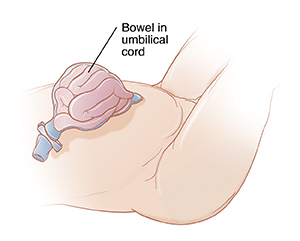A
B
C
D
E
F
G
H
I
J
K
L
M
N
O
P
Q
R
S
T
U
V
W
X
Y
Z
Click a letter to see a list of conditions beginning with that letter.
Click 'Topic Index' to return to the index for the current topic.
Click 'Library Index' to return to the listing of all topics.
Omphalocele and Gastroschisis in the Newborn
Omphalocele and gastroschisis are types of birth defects. They can occur in newborns. The cause of these defects is unknown. They happen when the body structures that are meant to hold the bowel (intestines) inside the belly (abdomen) don't form in the right way during the early weeks of pregnancy. Normally, the body wall and a membrane enclose the bowel inside the belly. But with these birth defects, the belly wall doesn't close. The bowel stays outside the body. Other organs, like the liver, may also be affected. Both of these problems must be fixed with surgery.
What is omphalocele?
With this birth defect, the bowel sticks out from the body through a problem in the umbilical cord. A membrane covers the bowel and protects it from damage and germs. A large omphalocele may also happen in other organs that stick out from the body. This birth defect occurs early in the baby’s development. It may be found on an ultrasound before the baby is born. The baby can sometimes be born vaginally.

What is gastroschisis?
With this birth defect, the bowel comes out of the belly through an abnormal opening in the belly wall. Other organs may come through as well. There is no membrane covering to protect these organs. This means they’re more likely to become damaged or infected. If your healthcare provider sees on an ultrasound that your child has gastroschisis, you will likely need to have a cesarean section. This helps lessen damage to the bowel.

How are the problems treated?
Omphalocele and gastroschisis both must be treated with surgery. This often takes place the day the baby is born. Treatment may involve the following:
-
The surgeon moves the bowel and other organs back into the belly. The surgeon closes the area of skin where they came through.
-
If the bowel is damaged, the surgeon may take out part of it before it’s put back into the belly. The surgeon then reconnects the healthy ends of the bowel.
-
In some cases, the baby’s belly is too small to hold all the organs. The surgeon then moves the organs back over time. This gives the belly time to grow. More than one surgery may be needed.
-
A healthcare provider will feed your baby through an IV (intravenous) line until the problem is fixed. IV feeding may last for some time afterward. Your baby will stay in the neonatal intensive care unit (NICU) during this time.
What are the long-term effects?
The long-term effects on your baby depend on the size of the defect. It will also depend on whether your baby has other physical problems at birth and whether any of the bowel must be taken out. Long-term feeding and digestive problems are possible. But most of these get better over time. Talk with your healthcare provider about how your baby is likely to progress.
Online Medical Reviewer:
Amy Finke RN BSN
Online Medical Reviewer:
Liora C Adler MD
Online Medical Reviewer:
Raymond Kent Turley BSN MSN RN
Date Last Reviewed:
2/1/2022
© 2000-2024 The StayWell Company, LLC. All rights reserved. This information is not intended as a substitute for professional medical care. Always follow your healthcare professional's instructions.